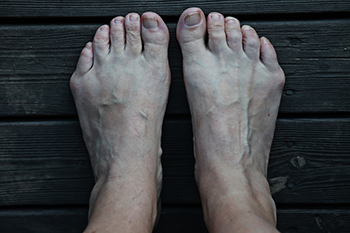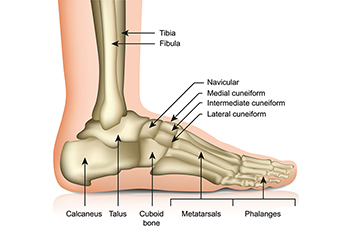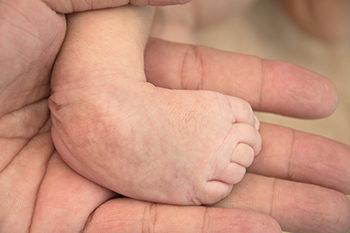April 2023
What Causes a Tailor’s Bunion?

A bunion is a bony bump that can develop on the side of an individual’s foot. Most commonly, the bunion develops on the inside of the foot near the big toe. However, a bunionette,, or tailor’s bunion, may develop on the outside of the foot near the pinky toes. Patients often ask about what exactly causes a tailor’s bunion. The answer is that there are a wide variety of different nuanced causes of a bunionette. First, a bunionette might develop when the feet do not function properly, causing the metatarsal bones to essentially separate. Second, the structure of the feet may change when an individual engages in new physical activities and sports. Third, bunionettes might also be caused by a hereditary disposition that is passed down through genetics. If you are someone living with a bunionette, it is suggested that you contact a podiatrist today for an appointment.
If you are suffering from bunions, contact one of our podiatrists of Bazzi Podiatry. Our doctors can provide the care you need to keep you pain-free and on your feet.
What Is a Bunion?
A bunion is formed of swollen tissue or an enlargement of boney growth, usually located at the base joint of the toe that connects to the foot. The swelling occurs due to the bones in the big toe shifting inward, which impacts the other toes of the foot. This causes the area around the base of the big toe to become inflamed and painful.
Why Do Bunions Form?
Genetics – Susceptibility to bunions are often hereditary
Stress on the feet – Poorly fitted and uncomfortable footwear that places stress on feet, such as heels, can worsen existing bunions
How Are Bunions Diagnosed?
Doctors often perform two tests – blood tests and x-rays – when trying to diagnose bunions, especially in the early stages of development. Blood tests help determine if the foot pain is being caused by something else, such as arthritis, while x-rays provide a clear picture of your bone structure to your doctor.
How Are Bunions Treated?
- Refrain from wearing heels or similar shoes that cause discomfort
- Select wider shoes that can provide more comfort and reduce pain
- Anti-inflammatory and pain management drugs
- Orthotics or foot inserts
- Surgery
If you have any questions, please feel free to contact one of our offices located in Detroit, West Detroit, Northwest Detroit, Sterling Heights, Hamtramck, Dearborn Heights, Madison Heights, Redford, and Livonia, MI . We offer the newest diagnostic and treatment technologies for all your foot care needs.
The Many Facets of the Foot

There are many moving parts each foot is made of. There are 26 bones along with several joints, tendons, and muscles that work together that enable the body to walk, run, and balance. Approximately one-quarter of all the bones that are in the body are located in the feet. Each toe has three joints, and the big toe has two joints. The calcaneus is considered to be the largest bone in the foot, and it forms the heel bone. The muscles provide the ability to move the feet, and each group of muscles provides a different function. The largest ligament in the foot is known as the plantar fascia, and it connects the heel to the toes. The Achilles tendon has the ability to provide mobility to the foot, and if an injury happens to this tendon, walking is often impaired. If you would like additional information about various components of the foot, it is suggested that you consult with a podiatrist who can give you interesting and useful knowledge.
If you have any concerns about your feet, contact one of our podiatrists from Bazzi Podiatry. Our doctors can provide the care you need to keep you pain-free and on your feet.
Biomechanics in Podiatry
Podiatric biomechanics is a particular sector of specialty podiatry with licensed practitioners who are trained to diagnose and treat conditions affecting the foot, ankle and lower leg. Biomechanics deals with the forces that act against the body, causing an interference with the biological structures. It focuses on the movement of the ankle, the foot and the forces that interact with them.
A History of Biomechanics
- Biomechanics dates back to the BC era in Egypt where evidence of professional foot care has been recorded.
- In 1974, biomechanics gained a higher profile from the studies of Merton Root, who claimed that by changing or controlling the forces between the ankle and the foot, corrections or conditions could be implemented to gain strength and coordination in the area.
Modern technological improvements are based on past theories and therapeutic processes that provide a better understanding of podiatric concepts for biomechanics. Computers can provide accurate information about the forces and patterns of the feet and lower legs.
Understanding biomechanics of the feet can help improve and eliminate pain, stopping further stress to the foot.
If you have any questions please feel free to contact one of our offices located in Detroit, West Detroit, Northwest Detroit, Sterling Heights, Hamtramck, Dearborn Heights, Madison Heights, Redford, and Livonia, MI . We offer the newest diagnostic and treatment technologies for all your foot and ankle needs.
Flip-Flop Straps

As the weather starts to get warmer, many individuals throughout the country will begin wearing flip-flops. Although this kind of footwear is fashionable for the incoming summer weather, it can also pose several health risks to your feet. Specifically, flip-flops have a retainer between the big and second toe. As a result, sometimes individuals may develop blisters or a sore in this area due to rubbing and friction. To mitigate this, an individual could consider opting for flip-flops made of fabric rather than plastic. More importantly, people should choose footwear besides flip-flops, such as a supportive pair of sandals. If you are someone that enjoys wearing flip-flops and experiences blisters between the big and second toe, it is suggested that you contact a podiatrist.
Flip-flops are not always the best choice of footwear. If you have any concerns about your feet or ankles, contact one of our podiatrists from Bazzi Podiatry. Our doctors will assist you with all of your foot and ankle needs.
Flip-Flops and Feet
When the weather starts warming up, people enjoy wearing flip-flops. Flip-flops are comfortable, stylish, and easy to slip on and off; they're perfect for any summer beach goer. However, these shoes can cause harm to the feet.
How Can Flip-Flops Affect Me Long-Term?
- Ankle problems
- Hip problems
- Lower back problems
- Pain in the balls of the feet
- Problems with foot arches
- Changes in the way you walk
Are There Injuries Associated with Flip-Flops?
Yes. Since flip-flops are relatively weak and do not provide the same amount of support as sneakers, people who wear flip-flops regularly are more susceptible to injuries. On top of that, the open nature of the shoe makes your feet more prone to other problems, such as cuts and even infections. Common injuries and ailments include:
- Sprained ankles
- Blisters
- Infections
- Cuts and Scrapes
I like Wearing Flip-Flops. Are There Safe Alternatives?
When buying flip-flops, try to find ones that have sturdy soles and that are made of high-quality materials that will support for your feet. These flip-flops will cost more but will also last longer as a result.
If you have any questions please feel free to contact one of our offices located in Detroit, West Detroit, Northwest Detroit, Sterling Heights, Hamtramck, Dearborn Heights, Madison Heights, Redford, and Livonia, MI . We offer the newest diagnostic and treatment technologies for all your foot and ankle needs.
Examples of Congenital Foot Conditions

Most babies are born with normal feet, despite the few structural abnormalities that may occur. These can include clubfoot and overlapping toes and may be treated without having surgery. Clubfoot is defined as developing in the womb, and the baby is born with twisted feet that point inward and down. Metatarsus adductus is a congenital foot condition that causes the baby’s toes to point in and they can be difficult to straighten. In severe cases, surgery may be necessary for permanent straightening. Babies who are born with one or more extra toes are known to be polydactyly. It is a fairly common condition and may happen for genetic reasons. Some babies are born with certain toes that overlap and are noticeable when the pinky toe crosses the fourth toe. It is generally not a bothersome condition, but special shoes may need to be worn. If you would like additional information about congenital foot problems, it is suggested that you confer with a podiatrist who can help you with the knowledge you are seeking.
Congenital foot problems require immediate attention to avoid future complications. If you have any concerns, contact one of our podiatrists of Bazzi Podiatry. Our doctors can provide the care you need to keep you pain-free and on your feet.
Congenital foot problems are deformities affecting the feet, toes, and/or ankles that children are born with. Some of these conditions have a genetic cause while others just happen. Some specific foot ailments that children may be born with include clubfeet, polydactyly/macrodactyly, and cleft foot. There are several other foot anomalies that can occur congenitally. What all of these conditions have in common is that a child may experience difficulty walking or performing everyday activities, as well as trouble finding footwear that fits their foot deformity. Some of these conditions are more serious than others. Consulting with a podiatrist as early as possible will help in properly diagnosing a child’s foot condition while getting the necessary treatment underway.
What are Causes of Congenital Foot Problem?
A congenital foot problem is one that happens to a child at birth. These conditions can be caused by a genetic predisposition, developmental or positional abnormalities during gestation, or with no known cause.
What are Symptoms of Congenital Foot Problems?
Symptoms vary by the congenital condition. Symptoms may consist of the following:
- Clubfoot, where tendons are shortened, bones are shaped differently, and the Achilles tendon is tight, causing the foot to point in and down. It is also possible for the soles of the feet to face each other.
- Polydactyly, which usually consists of a nubbin or small lump of tissue without a bone, a toe that is partially formed but has no joints, or an extra toe.
- Vertical talus, where the talus bone forms in the wrong position causing other bones in the foot to line up improperly, the front of the foot to point up, and the bottom of the foot to stiffen, with no arch, and to curve out.
- Tarsal coalition, when there is an abnormal connection of two or more bones in the foot leading to severe, rigid flatfoot.
- Cleft foot, where there are missing toes, a V-shaped cleft, and other anatomical differences.
- Macrodactyly, when the toes are abnormally large due to overgrowth of the underlying bone or soft tissue.
Treatment and Prevention
While there is nothing one can do to prevent congenital foot problems, raising awareness and receiving neonatal screenings are important. Early detection by taking your child to a podiatrist leads to the best outcome possible.
If you have any questions please feel free to contact one of our offices located in Detroit, West Detroit, Northwest Detroit, Sterling Heights, Hamtramck, Dearborn Heights, Madison Heights, Redford, and Livonia, MI . We offer the newest diagnostic tools and technology to treat your foot and ankle needs.





